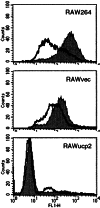Uncoupling protein 2 plays an important role in nitric oxide production of lipopolysaccharide-stimulated macrophages
- PMID: 12089332
- PMCID: PMC123151
- DOI: 10.1073/pnas.142206299
Uncoupling protein 2 plays an important role in nitric oxide production of lipopolysaccharide-stimulated macrophages
Abstract
The expression of uncoupling protein 2 (UCP2) was reduced in macrophages after stimulation with lipopolysaccharide (LPS). The physiological consequence and the regulatory mechanisms of the UCP2 down-regulation by LPS were investigated in a macrophage cell line, RAW264 cells. UCP2 overexpression in RAW264 cells transfected with eukaryotic expression vector containing ucp2 cDNA markedly reduced the production of intracellular reactive oxygen species. Furthermore, in the UCP2 transfectant, nitric oxide (NO) synthesis, inducible NO synthase (NOS II) protein, NOS II mRNA, and NOS II promoter activity were definitely decreased after LPS stimulation compared with those in parental RAW264 or RAW264 cells transfected with the vector alone. Reporter assays suggested that an enhancer element was located in the region of intron 2 of the UCP2 gene and that the UCP2 expression was down-regulated not by the 7.3-kb promoter region but by the 5' region of the UCP2 gene containing two introns. Deletion of intron 2 resulted in the low transcriptional activities and abolishment of the LPS-associated negative regulation. In addition, the mRNA expression of transfected UCP2 was suppressed in RAW264 cells transfected with expression vector containing UCP2 genomic DNA, but was markedly increased in cells transfected with the vector containing UCP2 intronless cDNA. These findings suggest that the LPS-stimulated signals suppress UCP2 expression by interrupting the function of intronic enhancer, leading to an up-regulation of intracellular reactive oxygen species, which activate the signal transduction cascade of NOS II expression, probably to ensure rapid and sufficient cellular responses to a microbial attack.
Figures







Similar articles
-
Negative regulation of LPS-stimulated expression of inducible nitric oxide synthase by AP-1 in macrophage cell line J774A.1.Biochem Biophys Res Commun. 2001 Dec 21;289(5):1031-8. doi: 10.1006/bbrc.2001.6123. Biochem Biophys Res Commun. 2001. PMID: 11741294
-
Antioxidant enzymes suppress nitric oxide production through the inhibition of NF-kappa B activation: role of H(2)O(2) and nitric oxide in inducible nitric oxide synthase expression in macrophages.Nitric Oxide. 2001;5(5):504-13. doi: 10.1006/niox.2001.0367. Nitric Oxide. 2001. PMID: 11587565
-
[Regulation of lipopolysaccharide-induced inducible nitric oxide synthase gene expression by protein kinase C].Zhonghua Yi Xue Za Zhi. 2002 Nov 10;82(21):1488-92. Zhonghua Yi Xue Za Zhi. 2002. PMID: 12509913 Chinese.
-
Uncoupling protein UCP2: when mitochondrial activity meets immunity.FEBS Lett. 2010 Apr 16;584(8):1437-42. doi: 10.1016/j.febslet.2010.03.014. Epub 2010 Mar 15. FEBS Lett. 2010. PMID: 20227410 Review.
-
Brain distribution of UCP2 mRNA: in situ hybridization histochemistry studies.Int J Obes Relat Metab Disord. 1999 Jun;23 Suppl 6:S53-5. doi: 10.1038/sj.ijo.0800947. Int J Obes Relat Metab Disord. 1999. PMID: 10454125 Review.
Cited by
-
Physiological roles of mitochondrial reactive oxygen species.Mol Cell. 2012 Oct 26;48(2):158-67. doi: 10.1016/j.molcel.2012.09.025. Mol Cell. 2012. PMID: 23102266 Free PMC article. Review.
-
Beta2-adrenergic receptor regulates Toll-like receptor-4-induced nuclear factor-kappaB activation through beta-arrestin 2.Immunology. 2008 Jul;124(3):348-56. doi: 10.1111/j.1365-2567.2007.02781.x. Epub 2008 Jan 11. Immunology. 2008. PMID: 18194271 Free PMC article.
-
Cytoprotective activity of mitochondrial uncoupling protein-2 in lung and spleen.FEBS Open Bio. 2018 Mar 12;8(4):692-701. doi: 10.1002/2211-5463.12410. eCollection 2018 Apr. FEBS Open Bio. 2018. PMID: 29632821 Free PMC article.
-
Mitochondrial network adaptations of microglia reveal sex-specific stress response after injury and UCP2 knockout.iScience. 2023 Aug 29;26(10):107780. doi: 10.1016/j.isci.2023.107780. eCollection 2023 Oct 20. iScience. 2023. PMID: 37731609 Free PMC article.
-
Overexpressed UCP2 regulates mitochondrial flashes and reverses lipopolysaccharide-induced cardiomyocytes injury.Am J Transl Res. 2018 May 15;10(5):1347-1356. eCollection 2018. Am J Transl Res. 2018. PMID: 29887950 Free PMC article.
References
-
- Fleury C, Neverova M, Collins S, Raimbault S, Champigny O, Levi-Meyrueis C, Bouillaud F, Seldin M F, Surwit R S, Ricquier D, Warden C H. Nat Genet. 1997;15:269–272. - PubMed
-
- Gimeno R E, Dembski M, Weng X, Deng N, Shyjan A W, Gimeno C J, Iris F, Ellis S J, Woolf E A, Tartaglia L A. Diabetes. 1997;46:900–906. - PubMed
-
- Klingenberg M, Huang S G. Biochim Biophys Acta. 1999;1415:271–296. - PubMed
-
- Arsenijevic D, Onuma H, Pecqueur C, Raimbault S, Manning B S, Miroux B, Couplan E, Alves-Guerra M C, Goubern M, Surwit R, et al. Nat Genet. 2000;26:435–439. - PubMed
Publication types
MeSH terms
Substances
LinkOut - more resources
Full Text Sources
Other Literature Sources
Research Materials

